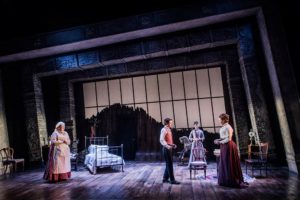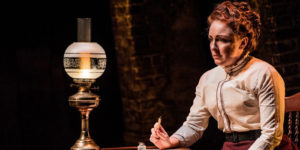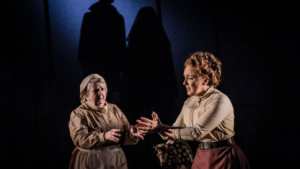Directed by Daniel Buckroyd, this new stage version of Henry James’ Turn of the Screw is a chilling tale of intrigue that keeps you guessing (and shuddering) long after the curtain falls. It follows the story of a young Governess in Victorian England who agrees to look after the niece and nephew of a charming but distant man. At first her new post seems idyllic, but it isn’t long before she discovers that the house is haunted – by secrets and spirits alike.
As I haven’t read the original novella, I can’t speak to the quality of translation from page to stage, but I can say how excellently the play, adapted by Tim Luscombe, was written – the interactions between characters gently but gradually simmering to boiling point, interspersed with the sporadic but scary appearances of disturbing apparitions. After having been underwhelmed by promised but undelivered scares in The Ghost’s Touch, it was refreshing to see a play which actually frightened the living daylights out of me. I generally have a very low threshold for jumpscares and the like (all of which is to say, I jump at the sight of my own shadow) but Turn of the Screw’s frights are earned and eerie, the creeping dread winding a turn at a time until the tension breaks with a bang (or a scream, as the occasion calls for). The opening moments set the scene perfectly – a rocking horse starts moving, seemingly all by itself, its creepy creaking the only sound in a fear-silenced auditorium. Its an image that Susan Hill skilfully incorporated into The Woman in Black, and in both mediums is just about the creepiest thing I’ve ever seen.
As the Governess, Carli Norris capably carries the show as our besieged heroine who finds herself wading through a mystical mire. She portrays a grounded, realistic, complex character who finds herself in a seemingly insurmountable situation. As the supporting characters – flesh and phantasm alike – grow stranger and stranger with each passing scene, Norris keeps the action from descending into caricature whilst also straying into strangeness when the plot demands. You’re completely invested in her character, even – or perhaps especially – as the unexplained oddities begin to pile up around her.
Annabel Smith has the tricky task of playing two polar opposite personalities, characters who could hardly be less alike. The transformation between the two isn’t always smooth, but Smith plays both characters with enthusiasm and verve. Smith’s Mrs Conray is the listener of the tale, demanding the Governess’ confession from a far-flung future; as such, Smith stands silent and still and sombre, a spectral figure who is almost as creepy as the ghosts which besiege the Governess – and the audience – throughout the play. The other character she portrays – well, you’ll just have to see the play to find out for yourself.
Michael Hanratty, credited only as The Man, plays a number of different characters, which between them represent a variety of different forms of masculinity. He plays the charming but apathetic uncle, the unusual nephew, as well as a good few ghosts. Norris and Hanratty are asked the most in terms of conveying complexity of character – in Hanratty’s case, conveying multiple complex characters – and create a fascinating dynamic between the Governess and the myriad male characters she meets through the course of the story. There are a lot of weird, unsettling, and possibly unnatural relationships that the cast craft throughout the drama, which the cast admirably strive (and often succeed) to lend credence to. And Maggie McCarthy channels Jane Eyre’s Grace Poole as Mrs Grose, a canny housekeeper who looks after the house and guards its secrets.
Having concluded that two was too few in terms of cast in The Ghost’s Touch, the four-strong cast here feels like the perfect number for a smaller show – some of the actors take on double or triple roles, others are on stage almost constantly. Given its Gothic nature, the play toys with the idea of doubling, duality, and the juxtaposition between the true self and the self one projects to the world. There are shades of light, darkness and grey in every character, particularly in the Governess herself, whose true character is left for you to decide even once the curtain falls. Of course, there are ghosts a go-go, as one would expect, but their inclusion is intellectual as well as insidious. Perhaps they are revenants of the past; perhaps they are figments of the imagination; perhaps they are a little of both. The action is adequately ambiguous to allow for any conclusion you come to.

The excellent acting across the board is enhanced by a truly spectacular set, wonderfully designed by Sara Perks – in psychoanalytical terms, I often read the location of a story as an external manifestation of the characters’ internal minds. Here, the off-kilter, slanted set evokes the odd, off-centre antics of its inhabitants; just looking at it makes you feel uneasy. Visually and thematically, it called to mind the warped altar during the climactic wedding scene in Tim Burton’s Beetlejuice, framing the characters in a twisted, unheimlich way. Matt Leventhall’s lighting and John Chambers’ music and sound effects also do a great deal to enhance the eerie quality of the play; the way the light plays on the sheet-covered furniture gives them a ghostly quality; and the windows lent themselves to some spine-chilling silhouettes at the denouement of the play. In addition, there is a fissure running through the boards, which lights up in fiendish orange at certain key points in the play, which not only heralds the arrival of a diabolical presence, but also looks like the gateway to some hellish dimension.
Scary and scintillating, Turn of the Screw proves itself to be just as gripping to modern audiences as it was to those of Henry James’ heyday. If you like your theatre to be thrilling, and you don’t mind sleeping with the lights on, this is a must-see.
Barbara Hughes Moore






1 thoughts on “Review Turn of the Screw, New Theatre Cardiff by Barbara Hughes-Moore”
-
Pingback: End of Year Update & 2019 Plans – The Law Lass
Get The Chance has a firm but friendly comments policy.